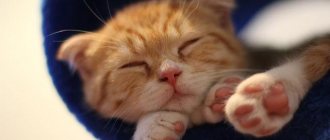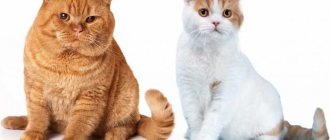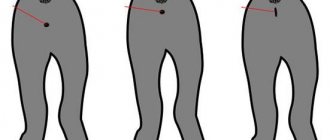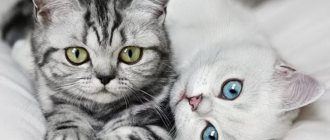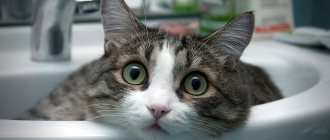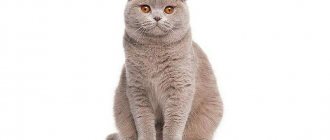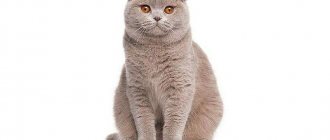British and Scottish cats are among the most popular cat breeds. They attract people primarily by their appearance and character. And while experts can easily distinguish between these cats, ordinary people still have difficulties.
Previously, until 2004, it was allowed to cross a British Shorthair cat with a Scottish Fold. This eventually gave rise to many misconceptions, for example, that there is a British Fold cat.
History of the origin of the British and Scottish breeds
There is a version that the ancestors of the British cat appeared on the English islands back in the 2nd century. BC. They lived in conditions of island isolation, adapting to the harsh climate, and therefore became the owners of the thickest wool.
Purposeful work on the breed began in the 19th century, trying to achieve denser wool and massive bones. The breeders succeeded. The British Shorthair is the owner of the densest fur of the cat breeds. During selection, the British were crossed with Persians, Russian Blues, and Chartreuse. Now interbreed matings are prohibited. Since, for example, the British received the gene for long hair from the Persians and long-haired Britons can still be born in the litter. This variety is called "Highlander".
The Scottish Fold (Scottish Fold) is the result of a gene mutation. The history of the breed began in 1961, when a cat with floppy ears was discovered on a farm in Scotland. A kitten from her litter was crossed with a British cat, which gave birth to 5 kittens, which became the founders of the Scottish Fold breed.
There are 4 varieties of Scottish cats:
- Scottish Fold - hanging, pressed ears + short hair.
- Scottish Straight – straight ears + short hair.
- Highland Folds are fold-eared cats with long hair.
- Highland Straight are straight-eared cats with long hair.
In its homeland, the Scottish Fold is not recognized and there are many opponents of its breeding due to health problems. The breed is extremely popular in the USA and a large number of nurseries are concentrated there.
Difference between British and Scottish cats
Externally similar cat breeds from Foggy Albion differ in structure, habits, and predisposition to diseases.
Breeding history and genetics
Short-haired cats appeared in the British Isles, as legend says, more than 2 thousand years ago, along with Roman legionnaires. As a result of long-term interspecific crossing in a humid and cool climate, a prototype of the breed with strong bones, dense coat, round head and large eyes was naturally formed.
The cats were exported to Europe and the United States, where they were called “domestic shorthaired cats.” They started thinking about breeding work at the end of the 19th century, when they decided to develop a purely English breed. At the origins of the creation of the British Shorthair breed was G. Weyer, the founder of the English association of cat lovers.
In 1880, representatives of the new breed were first demonstrated at a London exhibition. The first pedigree was issued in 1898. The First and Second World Wars pushed aside the concerns and problems of purebred British breeders. To restore the significantly reduced numbers of the British Shorthair breed, descendants of the British were sought in Europe and the United States.
To improve genetics and return to the breed standard, mating with cats of other breeds was used:
- Russian blue;
- chartreuse;
- Persian
As a result of crossing, the breed standard was slightly modified: in the width of the nose and the size of the eyes. After the 50s of the last century, the new breed was recognized by all felinological organizations in the world.
Expert opinion
Karnaukh Ekaterina Vladimirovna
Graduated from the National University of Shipbuilding, majoring in Enterprise Economics
The Scottish breed has two varieties of short-haired cats: fold-eared (Scottish Fold) and straight-eared (Scottish Straight). The impetus for developing a new breed was the interest in the unusual species and the love for the fold-eared cat of the Scottish farmer Mary Ross in the 60s of the last century. Having received a genetic mutant as a gift, a female kitten with floppy ears, she turned to breeders with a request to breed such a breed. The Fold cat and her son were crossed with a British cat and a cat and produced offspring considered to be the first representatives of the Scottish Fold.
Subsequently, it turned out that a fold-eared cat and a fold-eared cat cannot be crossed because of the danger of getting physical deformities. Geneticists have warned that the lop ear gene causes deformation of cartilage, not only in the ears, but also in other joints. For this reason, in 1971, the British Feline Organization refused to recognize fold-eared cats as a new breed.
The breed was saved by American scientists who proved that dangerous deviations in the physical development of kittens arise when offspring are born from fold-eared parents. Scots, bred according to special rules, do not have such problems. Breeding programs have been developed for breeders, which they have no right to violate.
Scottish Folds receive only one problematic gene that does not affect their health. In Europe, British cats are taken as pairs with fold-eared cats, and in the USA - American shorthairs. The Scottish Shorthair Fold was recognized as a separate breed in 1976.
Scottish Straight cats were recognized as a variety of the Scottish breed in 2004. The reason for the long refusal to register is the great similarity with the British. Felinologists changed their minds after a detailed study of the structure and habits of the animals. There are currently two genetic lines of Scots: European and American. “Americans”, compared to “Europeans,” have a more graceful structure and more tightly pressed ears. There are also Scots with different nose shapes: wide and long; small.
Color
The original British breed standard was blue. Currently, there are more than 100 color options.
Main types of colors of British cats (10 in total):
- plain or solid (9 options);
- tortoiseshell (9 options);
- Siamese colors (13 options);
- mixture with white (11 options);
- tabby or patterned (5 options);
- silver tabby (5 options);
- golden tabbies (5 options);
- smoky (4 options);
- silver chinchilla (9 options);
- golden chinchilla (2 options).
The concept of “color” of the British includes several characteristics:
- coat color;
- undercoat;
- eye;
- paw pads;
- nose lobes;
- wool pattern.
There is no difference in color between the Scots and the British due to crossbreeding. The predominant color initially, like the British, was blue. Breeders offer kittens of any color. The most popular are tortoiseshell, gold and silver.
Wool
The British Shorthair cat is characterized by a short, dense, elastic coat with a thick undercoat. The Scots have a soft coat with a longer pile.
Weight and body shape
The British cat has a well-balanced body, medium to large in size, on short, strong legs with round paws. The weight of sterilized males exceeds the weight of unsterilized males by 4-5 kg: from 5-8 kg it increases to 10-12 kg. Similarly for females: from 3-5 kg to 7-9 kg.
The weight of a male Scotsman is 5-7 kg, a cat is 4-5 kg. The body structure is proportional. The legs and tail are longer than those of the British.
Head shape
Both breeds have massive, rounded heads.
Muzzle and ears
The British muzzle is weighted down by the cheeks, which hang slightly on the sides. The pointed ears are located on a virtual centerline from the nose, passing through the eyes. The eyes are round and widely set. The nose is short.
Fold-eared cats have a rather high-cheeked muzzle, with a softly defined chin. The eyes are also round and widely spaced. The nose is short. The ears are set closer together than in the British, both the Scottish Fold and the Scottish Stayt.
Characteristic habits and temperament
Scottish cats are smart, but difficult to train. Animals love the company of their owner, but do not want to sit in their arms. They prefer to choose their own form of contact with a person: play or sleep next to them. Malice in nature is not typical for them. Friendly. Kittens quickly get used to their new place of residence and owners.
The British breed has similar character traits to the Scottish one:
- smart;
- stubborn;
- not aggressive.
Expert opinion
Karnaukh Ekaterina Vladimirovna
Graduated from the National University of Shipbuilding, majoring in Enterprise Economics
British and British women are clean from an early age. The licking procedure has a calming effect on them. Thanks to her, they experience stress. Cats of this breed do not shit in corners, provided that the litter box is clean. Don't raise your voice at your pet. He himself never meows loudly and does not like being shouted at. The offended Briton is not the first to reconcile. It shows its love for its owner with restraint and can easily withstand his long absence.
Nuances of care and feeding
Cats of both breeds are unpretentious in keeping. They thrive on dry food and natural products, provided that their diet is balanced with healthy ingredients. When choosing dry food, it is important to follow nutritional standards based on age and weight.
Common pet care:
- brushing 2-3 times a week, daily during molting;
- prevention against worms;
- once a month – bathing;
- trimming claws if the animal does not use a scratching post;
- monitoring the condition of the eyes and ears;
- teeth cleaning.
It is especially important to monitor the ears of fold-eared cats. Once a week you need to clean them of plaque using special products and a cotton swab.
Health and susceptibility to disease
The Scots and British are hardy animals with strong immunity. At the same time, they have “weak” points that cat owners should be aware of.
Diseases to which both breeds are susceptible:
- conjunctivitis;
- urolithiasis disease;
- cardiomyopathy.
British cats are prone to obesity. Kittens can have 2 blood groups in their bodies, which leads to their death after 3 days. Scottish Folds may develop diseases of the musculoskeletal system and ears.
Pair formation and mating
When choosing a partner for a British cat, they take into account the characteristics that must match in order to obtain high-quality offspring:
- blood type;
- eye color;
- color (according to pedigree, in some cases it must match);
- size (close).
Among the Scots, crossbreeding should only occur between the Scottish Fold (cat or she-cat) and the Scottish Stay (cat or tom). When choosing a pair, pay attention to the color.
Mating of a British female and a Scottish female should be planned when she is at least 1 year and 3 months old, after 2-3 heats.
Breeding Features
Mating between two Scottish Folds is prohibited due to the high risk of problems with the skeletal system of the body. The gene responsible for lop ears affects not only the development of ear cartilage, but also the cartilage of the entire body. This leads to deformity and disability. That's why they knit fold + straight. In a litter, both kittens with floppy ears and straight ones can be born. It is the straight-eared straight cats that are confused with British cats.
The fact is that in the 80s. In the 20th century in Europe (mainly in the UK), matings were carried out between British and Scottish cats to reduce the incidence of animal diseases and diversify colors.
British advantages
The British breed was developed quite a long time ago. Even the Scots descended from her, with whom the comparison will be made. If you prefer large cats, then a representative of the British breed is suitable. The weight of an adult reaches 6–7 kg.
The Briton is usually calm and tolerates the long absence of his owners well. If there are children in the family for whom the kitten is purchased, then you should not choose a representative of this breed. The entire history of studying the behavior of the British indicates that they are loners. Cats of this breed are especially not prone to active noisy games.
The British are excellent hunters. Only often they are too lazy to chase the mouse.
The advantages of the British include:
- calm, balanced disposition;
- ease of upbringing and training;
- rich, majestic appearance;
- lack of aggression;
- variety of colors and lengths of wool.
But do not be mistaken: for all their aristocratic nature, the British do not have unlimited patience and will never become that submissive toy that can be tied in a knot.
External differences between the British and Scots
Ears, head and body shape are the main differences between British and Scottish cats. Since 2004, each breed has consolidated its characteristic features, which is clearly visible in the photo. At the same time, both British and Scottish cats have large round eyes, powerful whisker pads, lush cheeks, and a rounded head.
However, the British cat (more noticeable in males) stands out against the background of the Scotsman. With age, the differences increase: the British cat becomes more brutal, while the Scots cat retains his “baby face.”
| Characteristic | British cat | Scottish breed |
| Ears | Only straight, widely set. If you visually draw a line connecting the nose and the center of the eye, then in a thoroughbred Briton it passes through the center of the tip of the ear. | Straight ears are straight, pointed, narrower than those of the British. The distance between the ears is much smaller. The ears are positioned so that a line from the tip of the nose through the center of the eye runs along the outer edge of the ear. Ear cartilage is softer to the touch. Folds have small ears that are curved and pressed down. |
| Head | Big, round. A strong chin with plump cheeks forms the signature British smile. The expression on the face is serious and businesslike. | The head is round and looks small in relation to the body. Reminds me of an owl's head. There is an expression "baby face" that perfectly suits the Scots. Tenderness is what the faces of Scottish cats express. |
| Eyes | The eyes are set wide apart, round and large. The look is heavy. | The eyes are round, but slightly smaller than those of the British. |
| Cheeks | The bigger the cheeks, the better. Because of the short neck, it seems that the cheeks touch the shoulders, this is especially noticeable in cats. | The cheeks should not interfere with the overall roundness of the head and extend beyond the muzzle. The cheek size is significantly smaller compared to the British ones. |
| Nose | The nose is wide and straight. | The nose is narrower than British and slightly elongated. |
| Backbone | Powerful, stocky and squat body. Wide chest. The neck is short and massive. Almost invisible. | The body is slightly elongated in length and medium in size. Looks graceful. |
| Legs | Legs are short. Powerful paws | The limbs are longer, making the Scots look taller. |
| Tail | The tail is short and rounded at the end. Thick and strong. | The tail is long, tapering towards the tip. Much more mobile than the British one. |
| Wool | Plush, stuffed with double undercoat. The undercoat and coat are equal in length. Hence the density. Blue and lilac cats have especially dense fur coats. | The undercoat is slightly shorter than the guard. Therefore, the coat is not as dense as that of the British, but soft and silky. |
| Weight | 4.5-9 kg. Cats are much larger than cats. These are powerful, stocky animals. Included in the list of the largest breeds. | 3-6 kg. Sexual deformity is strongly expressed. Therefore, cats will be noticeably different in size from female cats. |
Who is better to choose
It is difficult to say which breed is better, British or Scottish. The choice of a pet is based on the preferences of the future owner, daily routine and rhythm of life. The British cat quickly becomes attached to the house and considers himself a full member of the family. He likes to be left alone for a long time, but a purebred animal needs proper care and timely education.
The British man’s appearance is brutal, his behavior is very important. It is no coincidence that previously only the rich segments of the population could afford to keep such cats. The facial expressions of pets are interesting and funny. Up to a year old, babies are playful and active, but closer to the age of two, the cat’s habits change, she becomes calm and sleepy. The baby loves to sleep, lounging on the plush back.
The Scottish cat, as a kitten and as an adult, is playful and noisy. He will run around at night or run around the apartment with a rubber mouse.
The Scottish woman loves children, she likes the attention of the owner and family members. Everything in it is for a large and noisy company:
- A funny pose in which your pet often sits: on its tail, with its long legs outstretched.
- Or the famous gopher stand, when the baby stretches vertically on its hind legs, tucking its front legs.
- Ability to walk on a leash and follow various commands.
This cat combines the qualities of cats and dogs. Caring for a cat is not difficult. The Scottish favorite cannot stand heights: flying from the top shelves is not possible for the animal due to the structure of its limbs.
How to distinguish a British kitten from a Scottish one
The difference between British and Scottish cats is obvious. It makes no sense for nursery owners to deceive those who want to buy babies of a certain breed.
The smaller the kitten, the more difficult it is to distinguish a British cat from a Scottish pet. Characteristic signs appear as the baby grows older. Therefore, it is better to buy a baby at the age of 2-3 months.
By this time, the Scotchfold ears, straight from birth, will acquire the desired fold. The eye color will gradually begin to acquire a constant shade that matches the color of the animal's coat. A mandatory item when choosing a kitten is to check the baby's tail: for a fold-eared baby, it should be long and mobile. The British have a powerful, thick tail, much shorter than that of the Scot.
The main points of difference between kittens of the British and Scottish breeds, which people pay attention to when choosing babies:
| British kittens | Scottish kittens |
| Heavier paws, clubfoot when walking | Long light limbs |
| Chubby cheeks | Cheekbones are not very pronounced |
| Large baby | Small in size |
| Round head | Elongated skull shape |
Babies do not differ much in their habits: up to a year old, representatives of these breeds are active and respond to play with pleasure. The difference in behavior between the British and Scottish cats will be noticeable in later life.
To the touch, the Scottish have fur that is more fluffy and soft, gliding, while the British have dense and thick fur. An inexperienced buyer will not be able to independently determine what breed the cub belongs to. The difference in behavior between the British and Scottish cats will be noticeable in later life.
Differences in Personality
It is difficult to compare two almost related breeds in character. Each cat is an individual, so a representative of even the same breed can have a colossal difference in character and habits.
In general, it is precisely for the character that both English breeds have found so many fans:
- balanced and calm;
- friendly;
- clean;
- they love communication with a person, affection, but do not get bored;
- devotees;
- They are calm with children and other pets.
Both the British and the Scots do not welcome being squeezed, picked up, or carried.
Both breeds are endowed with high intelligence and quickly become accustomed to the litter tray, scratching post, and rules established at home. But they are difficult to train.
Hunting instincts are equally well developed.
Despite the similarity, it is still noted that there is a difference between British and Scottish cats in temperament:
- The British are softer, while the Scots are assertive.
- The British are independent, have a great time alone, which is why they have earned the name “business cats.” They are introverts and phlegmatic. The Scots are more social, they love company and play.
- British cats are lenient towards children and animals. Scottish ones love to play with them and are friendly. They will also make friends with the dog, even if it came into the family later. It is believed that for families with children it is better to choose a Scot.
Scottish cats are famous lovers of standing on their hind legs. In the meerkat position, they can spend a lot of time observing what is happening.
Another feature of the Scots is that they sit in the Buddha pose. The hind legs are extended forward, the front legs lie on the stomach.
Maintenance and care
Representatives of this cat breed are well suited for keeping in private homes. They love space and can walk around the site, hunt birds or rodents. They tolerate low and high temperatures well. It is worth remembering that in the summer or if the apartment is hot, the animal must have unlimited access to water. The ability to quench their thirst is very important for cats. They easily wait for the next feeding, but have a hard time with the lack of water.
To maintain health, it is recommended to regularly visit the veterinarian, take the necessary preventive measures, and get vaccinated. If the owner is thinking about castrating his pet, this should be done at the age of about 9 months. This measure will relieve the animal from physiological suffering associated with periodic fluctuations in hormonal levels, and the owner from the characteristic smell in the apartment. Only those individuals that are intended to be used for breeding are not castrated.
Proper maintenance and care involves a number of activities that the pet owner must periodically carry out. Twice a year the cat needs to be washed with special shampoos. Conventional products can cause irritation to the animal's skin.
It is necessary to wipe the corners of the eyes from discharge and dirt. The ears also need to be kept clean. Sulfur, secretion, and dirt collect in them. Clean your ears once every two months. To do this, you can use cotton sponges, cotton swabs, and peroxide. Do not penetrate deeply into the ear canal, as this can damage the eardrum.
To clean your teeth, use special brushes and special pastes. If the cat receives solid food periodically, teeth brushing occurs during meals. Once every six months, it is worth having a veterinarian check for oral diseases.
There must be a scratching post in your house or apartment. If this measure is not enough, you need to periodically trim the claws. There is a special nail clipper for this; ordinary scissors will damage the skin of the paws.
The cat needs to be brushed. For individuals with short hair, this can be done once a week. It is better to comb it than to clean the apartment every day. For animals with thick, long hair, this procedure should be done every day.
It is important to choose a convenient tray. It is better to discuss toilet issues with the breeder. What is important here is the animal’s habits, which were established in childhood.
How to distinguish a British kitten from a Scottish one
When kittens are born to a Scottish cat, at first (up to 3-4 weeks) they all have straight ears. During this period, it is difficult to distinguish not only a Briton from a Scot, but also a Scottish Fold kitten from a Straight. Then the ears begin to bend or remain in a standing position.
Pedigree fold-eared kittens may have ears with different types of folds:
- Single – the ears are folded in half and just hang.
- Double fold and ears pressed tightly to the head.
- Triple fold.
In the case of straights it is more complicated. Only an expert can determine that a Scottish kitten is. Also in the pedigree there must be a corresponding entry:
- SFS stands for Scottish Fold
- SFS71 – Scottish Straight
- BRI – British Shorthair.
Still having trouble choosing?
Still wondering whether the British or the Scots are better, who to choose? You can compare the parameters of a particular breed for a long time until you meet YOUR CAT. This is a standard situation when a person decides that he will take such and such a breed, such and such a gender, such and such a color. This person comes to the nursery and leaves with an animal of a different breed, a different sex and a different color. How does this happen?
Choosing a kitten is not logic, but emotions, if we are talking about an animal not for business, but for the soul. You can say a million times that you won’t take a cat, that you only need a cat. There are a million times you may not want an animal of a certain color. And then you meet HIM or HER and realize: this is THE SAME. He may be the wrong color, the wrong gender, or even the wrong breed, but a spark has jumped between you. Logic may suggest otherwise, but the mind gives up in such situations. Therefore, do not sit studying theoretical materials longer than necessary. Go see live kittens. You will be surprised how easy the choice will be when you meet YOUR cat.
Source
Popular colors
Harlequin Scottish Fold There are several main colors of Scottish Folds:
- Solid (solid) - the pet is painted in one color and has no inclusions of another color. These colors can be chocolate, gray, purple, blue, black and others.
- Tortoiseshells. The coat is colored in two colors, harmoniously distributed throughout the animal. The chest and paws have one of the colors.
- Smoky color. The coat is colored in a single color, with a predominantly silver-white undercoat.
- Chinchilla. The hair has a white base at 7/8, the rest is colored differently.
- Tabby - color similar to brindle, with characteristic stripes, spots, and marbled pattern on the body.
- Bicolor. The wool combines white and blue, black and red. It is desirable to have white on the paws, belly, and chin.
- Wang. The color of the coat is white, except for the tail and two spots on the head.
- Harlequin. The base is white, with a few spots on the body of a different color.
- Color point. The entire coat is light in tone, the tail and muzzle are colored in a contrasting shade.
These are the main colors characteristic of all Scottish fold cats.
Interesting read: who are the lop-eared Britons?
wcf breed standards
The main feature of the Scottish Fold breed is its ears. In addition, there are strict standards for this breed that set standards for animals. The body of the Scottish should be of medium size, with well-developed muscles and a stocky build. The animal's chest is wide. The paws are short and round in shape. The tail should be of medium length and reach the animal’s shoulders, with a rounded tip. There are no bulges throughout, with good flexibility.
The head is rounded, wide, with a pronounced chin that stands out on the skull. The nose is short and straight, curved in profile. The mustache pads are round in shape and should also be pronounced. Round big eyes.
Basic rules of hygiene
Also, care is important for a cat, which consists of certain hygiene procedures. Coat care involves regular brushing - once a week. To do this, you will need a special brush for short hair. Scottish cats rarely have ear problems, but they need to be examined every ten days. To clean them, you will need special solutions that can be found in veterinary stores. If your eyes start to run, syntomycin ointment will help.
For any cat you need to purchase a scratching post, otherwise the wallpaper, furniture, and doors will suffer. You can trim your claws periodically. This must be done especially carefully so as not to damage the living area of the nail. It is recommended to wash fold-eared cats once a month. It is better to use warm water, using only special shampoos for cats.
Interesting material: how to choose a Scot and care for him.
Walking your pet
All Scottish cats are domestic cats. They do not require walking outside, especially if they live in the city. Loud noises, car horns, and other animals can frighten the animal. If the pet lives outside the city, they can walk on their own property. So they will not meet other animals, especially stray dogs and especially wild animals, if we are talking about villages.
Scottish mixed cat
Metis, that is, a cross between two different breeds, is an unpredictable creature, because its genes can appear in the most unexpected combinations. Sometimes they turn out to be successful (for example, a softer character or good health appears), sometimes they are undesirable. Let's see what the consequences are and what kittens are born from two different breeds.
Attention! Information about the possible origin of the mestizos presented in the article is approximate, because without having documents for the cat, it is impossible to say what breed it is. Roots can only be determined approximately by eye. Therefore, if we say that a given cat is a Scots-Persian mix, then there is no 100% guarantee that this is really the case. However, these cats look exactly like mixtures of these breeds.
What does a mestizo look like?
Half-breeds contain the features of both parents, so their appearance allows for any deviations. The main external data of a mixture of British and Scots is shown in the table:
| Part of the body | Characteristic |
| Torso | Powerful, stocky, rough |
| Head | Round, large |
| The nose is straight, the transition from the forehead to the muzzle is noticeable | |
| Developed chin | |
| Ears | Pyramidal, erect |
| Incomplete forward fold in those who have the gene for lop ears | |
| Paws | Powerful, thick, rounded pads |
| Eyes | Round, wide open |
| Any shade, colors can be mixed | |
| Tail | Elongated, thick |
| Wool | Short, thick, tight-fitting |
| There is undercoat | |
| Color | Plain, mostly blue or tabby pattern |
Return to contents
Is it possible to cross breeds?
When is breeding possible?
Folds no longer mate with Scots. However, sometimes this is necessary to improve the color or gain new features in appearance. Experimental matings are carried out, and the litter is carefully studied by specialists. Interbreed mating is undesirable, since the standard characteristics are lost, and the babies may develop joint problems in the future.
When is breeding prohibited?
The Fold cat can only mate with Scottish cats with straight ears due to a gene that lowers the ear flaps. Only one carrier of such a gene is allowed in a couple, otherwise the offspring will die or have severe genetic abnormalities. There is no ban among the British. Only cats with deviations from the standard - malocclusion, squint, or creases in the tail - are not allowed for breeding.
